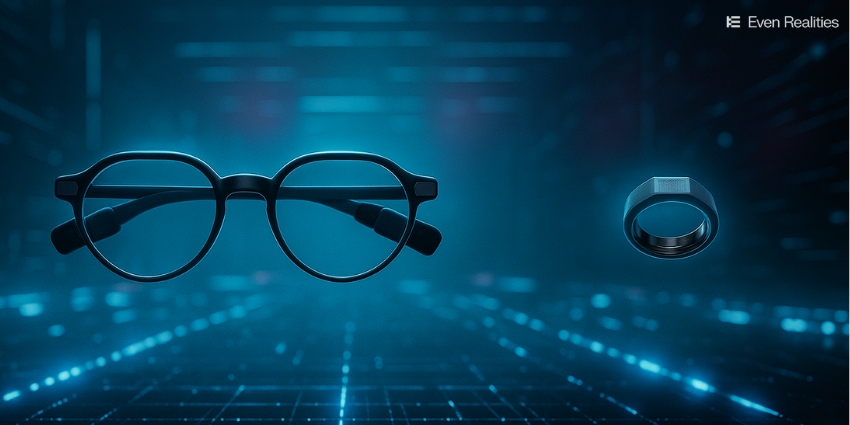We’ve all been here before: another revolutionary workplace technology promises to transform productivity while systematically turning us into notification-addled multitasking zombies. The pattern is depressingly familiar—new tools arrive with fanfare about streamlining workflows and eliminating inefficiencies, then promptly add three more applications to juggle and five new types of alerts to ignore. So when I say that passive AI in smart glasses might actually be different, I understand if your first instinct is to roll your eyes and mutter something about fool me once, shame on technology vendors; fool me seventeen times, shame on optimistic tech journalists.
But if you’re a business leader who’s grown tired of watching employees toggle between seventeen browser tabs while simultaneously managing three chat applications and pretending to pay attention in Zoom meetings, this latest development might actually break the cycle of productivity theater we’ve all been trapped in. The irony, of course, is that our solution to technology overload involves… more technology. But bear with me here—this time might actually be different.
The Exhaustion of Active Interaction
Walk through any modern office, and you’ll witness the paradox of productivity technology. Employees juggle multiple screens, toggle between dozens of applications, and respond to an endless stream of notifications—all while trying to focus on their actual work. We’ve created digital environments that demand constant attention rather than supporting natural workflow.
“The idea that this is all going to be driven predominantly by voice, of asking questions and almost like becoming an AI agent that can look around and say, ‘Oh, you forgot your keys over here,’ right?” explains Kirin Sinha, CEO and founder of Illumix, describing the shift toward passive, ambient intelligence.
This represents a profound departure from our current model of human-computer interaction. Instead of commanding technology to perform tasks, we’re moving toward AI that observes, understands context, and proactively offers assistance when needed.
While current smart glasses face significant adoption barriers, the integration of passive AI capabilities addresses many of the fundamental usability concerns that have limited enterprise deployment. Rather than requiring users to learn new interaction paradigms, passive AI systems work within existing behavioral patterns.
The Science of Ambient Awareness
Traditional productivity tools require what cognitive scientists call “executive attention”—the mental energy we use to consciously direct our focus. Every time you check your phone, open an app, or respond to a notification, you’re depleting this finite resource.
Passive AI operates differently. Like peripheral vision, it processes information in the background without demanding conscious attention. Smart glasses equipped with contextual awareness can monitor your environment, understand what you’re working on, and surface relevant information precisely when it becomes useful.
The Contextual Computing Revolution
The breakthrough isn’t just in miniaturized displays or improved battery life—it’s in what researchers call “contextual computing.” This technology combines computer vision, spatial awareness, and multimodal AI to understand not just what you’re looking at, but why it matters in your current workflow.
Consider the difference between searching for information and having information appear contextually. The first requires interrupting your task, formulating a query, and processing results. The second seamlessly integrates assistance into your natural workflow.
As we’ve explored in our analysis of the XR inflection point approaching in 2026, the convergence of AI capabilities with improved hardware is creating conditions for genuine breakthrough applications rather than incremental improvements.
Real-World Workplace Scenarios
Manufacturing and Field Service
In manufacturing environments, passive AI transforms how technicians interact with complex machinery. Instead of consulting manuals or tablets, smart glasses can recognize equipment through computer vision and overlay relevant maintenance data, safety warnings, or repair instructions directly in the technician’s field of view.
Sarah, a field service engineer, approaches a malfunctioning industrial printer. Her smart glasses instantly identify the model, display recent service history, and highlight the component most likely causing the current error code—all without her requesting any information.
This scenario eliminates the cognitive overhead of switching between tools while providing more relevant, timely assistance than traditional interfaces.
Healthcare and Patient Care
Healthcare workers face particularly acute attention management challenges. Passive AI can monitor patient interactions and surface critical information—medication allergies, recent test results, or protocol reminders—precisely when relevant.
Dr. Martinez enters a patient room. His smart glasses recognize the patient through secure biometric identification and discretely display key vitals trends and medication schedules, allowing him to maintain natural eye contact while staying informed.
The technology reduces medical errors while preserving the human connection that’s essential to quality care.
Training and Skill Development
Traditional training often requires stepping away from actual work to consume educational content. Passive AI enables just-in-time learning that adapts to real-world situations.
A new employee assembling products receives contextual guidance overlay showing proper technique, quality checkpoints, and safety reminders—but only when the AI detects they’re performing related tasks.
This approach accelerates skill acquisition while reducing the disruption typically associated with training programs.
The Privacy Paradox: Building Trust in Ambient Intelligence
The most sophisticated passive AI systems require comprehensive environmental awareness—they need to see what you see, understand what you’re doing, and often access sensitive business information. This creates unprecedented privacy considerations that organizations must address proactively.
Data Minimization and Edge Processing
Leading passive AI implementations address privacy through architectural choices rather than policy alone. By processing visual information locally on the device rather than transmitting it to cloud servers, these systems can provide contextual assistance while minimizing data exposure.
Edge computing enables smart glasses to understand “you’re looking at the quarterly revenue spreadsheet” without transmitting the actual financial data anywhere.
This technical approach provides both privacy protection and performance benefits, since local processing eliminates latency that would make ambient assistance feel sluggish or intrusive.
Consent and Control Mechanisms
Successful passive AI deployments give users granular control over what information the system can access and when assistance is welcome. This might include “focus modes” that disable ambient features during sensitive conversations or “learning modes” that increase contextual awareness during training periods.
The key insight from early adopters is that transparency builds trust more effectively than restriction. Employees who understand how passive AI works and what data it processes are more likely to embrace its productivity benefits.
Overcoming the Adoption Hurdle
The Invisible Onboarding Challenge
Unlike traditional productivity software with obvious interfaces and clear feature sets, passive AI systems succeed when users barely notice them. This creates a unique onboarding challenge—how do you train people to use technology that’s designed to be unconscious?
Successful deployments focus on gradual introduction rather than comprehensive training. Early implementations might provide only basic contextual information, gradually expanding capabilities as users become comfortable with ambient assistance.
This approach directly addresses the adoption concerns outlined in our previous analysis of smart glasses adoption challenges. By making the technology less demanding rather than more feature-rich, passive AI systems sidestep many traditional barriers to enterprise XR adoption.
Cultural Shift Management
The transition to passive AI requires more than technical implementation—it demands cultural adaptation. Organizations must help employees develop new relationships with technology that feels less like tool usage and more like enhanced capability.
Change management strategies include demonstrations of passive AI reducing cognitive load rather than increasing productivity demands, and frameworks for measuring success based on work quality rather than just efficiency metrics.
The Competitive Advantage of Ambient Intelligence
Organizations that successfully deploy passive AI systems report qualitative improvements that traditional productivity metrics struggle to capture. Employees describe feeling more present in meetings, less overwhelmed by information management, and more confident when handling complex tasks.
These benefits compound over time. Workers who experience reduced cognitive load can tackle more challenging problems, engage more deeply with colleagues, and maintain focus for longer periods. The result is a sustainable productivity improvement rather than the temporary efficiency gains typical of most workplace technology.
The 2026 Timeline Reality
The convergence of technological readiness and market conditions suggests that passive AI applications will move from experimental deployments to mainstream adoption within the next two years. As hardware manufacturers address current limitations and software platforms mature, the practical barriers to enterprise implementation continue to diminish.
This timeline aligns with broader industry predictions about when XR technologies will achieve genuine workplace integration rather than remaining niche applications.
Ponder This: The Future of Human-Computer Collaboration
What fascinates me most about passive AI is how it represents a fundamental evolution in our relationship with technology. For decades, we’ve adapted our behavior to accommodate digital tools—learning keyboard shortcuts, memorizing menu structures, and developing habits around notification management.
Passive AI reverses this dynamic. Instead of humans adapting to technology, AI systems adapt to human workflow patterns. This shift has profound implications beyond productivity. It suggests a future where technology augments human capability without demanding constant attention or behavioral modification.
The organizations that recognize this transition early will gain significant advantages. They’ll attract employees seeking less stressful, more focused work environments. They’ll reduce the cognitive overhead that limits innovation and creative problem-solving. Most importantly, they’ll demonstrate that technology can enhance human potential rather than simply automating routine tasks.
The question isn’t whether passive AI will transform workplace productivity—early deployments are already proving its value. The question is whether your organization will lead this transformation or scramble to catch up when ambient intelligence becomes the baseline expectation for knowledge work.
Join the conversation with 2,000+ XR professionals in our LinkedIn community and get the latest industry insights delivered to your inbox by subscribing to our weekly newsletter.







